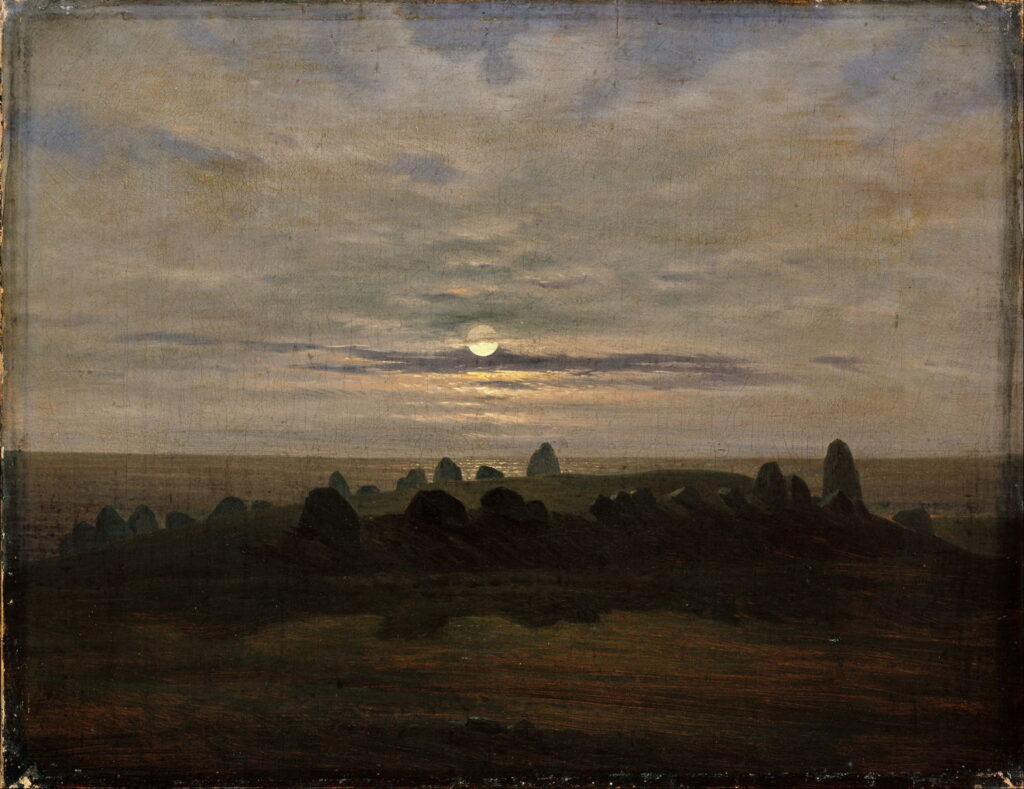Paintings by a Baltic Beach 1

It’s time for a trip to the Baltic Sea. Although still early in the season, this weekend I explore the Baltic coast, home to a succession of major artists from Caspar David Friedrich, born in what was then Swedish Pomerania and now the German city of Greifswald, to Lovis Corinth, born in Tapiau near Königsberg and now in the Russian exclave of Kaliningrad. We’ll keep more to the south, where the sea should be starting to warm, and the resorts opening up after winter.
Friedrich was perhaps the first major landscape artist to paint this region, and was soon followed by other German Romantic painters.
Caspar David Friedrich (1774-1840), The Abbey in the Oak Wood (1808–10), oil on canvas, 110.4 × 171 cm, Alte Nationalgalerie, Berlin. Wikimedia Commons.
His Abbey in the Oak Wood from 1808–10 shows the ruins of a church amid gnarled and barren trees, silhouetted against a twilight sky. These are the imposing remains of the former Cistercian monastery near Greifswald in Pomerania, just to the south of Germany’s Baltic coast. Founded in 1193, the abbey was dissolved in 1535, and fell derelict from 1650 onwards. It became a favourite haunt of Friedrich and his pupil Carl Gustav Carus.
Caspar David Friedrich (1774–1840), Greifswald in Moonlight (1817), oil on canvas, 22.5 × 30.5 cm, Nasjonalgalleriet, Oslo, Norway. Wikimedia Commons.
Friedrich’s early coastal nocturnes include meticulously detailed views such as this of Greifswald in Moonlight (1817). This was the city of his birth, on the coast of north-east Germany. At that time it was part of Swedish Pomerania, a former Swedish dominion, which was ceded to Denmark in 1814, then to Prussia in 1815, just a couple of years before Friedrich painted this view.
Caspar David Friedrich (1774–1840), Chalk Cliffs on Rügen (after 1818), oil on canvas, 90.5 × 71 cm, Museum Oskar Reinhart am Stadtgarten, Winterthur, Switzerland. Wikimedia Commons.
When Friedrich married Caroline Bommer on 21 January 1818, the couple honeymooned in Greifswald, Stralsund, and on the island of Rügen, on the Baltic coast. His famous Chalk Cliffs on Rügen, painted after their honeymoon, show the island’s dazzling white pinnacles of chalk in this distinctive and enigmatic view.
Carl Gustav Carus (1789–1869), Ruins of the Eldena Monastery with a Cottage near Greifswald in Moonlight (1819-20), oil on canvas, 43 x 33 cm, Pommersches Landesmuseum, Greifswald, Germany. Wikimedia Commons.
Carl Gustav Carus’ Ruins of the Eldena Monastery with a Cottage near Greifswald in Moonlight from 1819-20 is another view of the former Cistercian monastery near Greifswald.
Carl Gustav Carus (1789–1869), Stone Age Stronghold at Nobbin, Rügen Island (c 1820), oil on canvas, 33.5 x 43 cm, Nasjonalgalleriet, Oslo, Norway. Wikimedia Commons.
In about 1820, Carus painted this Stone Age Stronghold at Nobbin, Rügen Island, a neolithic site on the island. He uses the muted and faintly sinister light of the moon to enhance the drama of this ancient stone circle.
Caspar David Friedrich, Chalk Cliffs on Rügen (c 1825-6), watercolour and pencil on paper, 31.7 x 25.2 cm, Museum der bildenden Künste, Leipzig. Wikimedia Commons.
Friedrich visited the island of Rügen after his honeymoon. During one visit in about 1825-26 he painted in watercolour what might appear to have been a study for his earlier oil painting. The three figures have gone.
Carl Gustav Carus (1789–1869), Memory of a Wooded Island in the Baltic Sea (Oak trees by the Sea) (1834-35), oil on canvas, 117.5 x 162.5 cm, Galerie Neue Meister, Staatliche Kunstsammlungen Dresden, Dresden, Germany. Wikimedia Commons.
Carus doesn’t specify which island he painted in his Memory of a Wooded Island in the Baltic Sea (Oak trees by the Sea) from 1834-35, although this is almost certainly a part of the Rügen archipelago.
With the end of German Romanticism, paintings of this part of the Baltic coast became infrequent until the later nineteenth century, when it was visited by a new generation of artists.
Eugen Bracht (1842–1921), Göhren on Rügen (1877), oil on canvas mounted on cardboard, 47.3 x 34 cm, location not known. Wikimedia Commons.
Eugen Bracht was born in Switzerland, but moved to northern Germany, from where he visited and painted its Baltic coast. Göhren on Rügen from 1877 is a magnificent oil sketch of this location when it was still relatively wild, complete with a feral goat.
Eugen Dücker (1841–1916), Rügen (1885), oil on canvas, 85 x 132 cm, Museum Kunstpalast, Düsseldorf, Germany. Wikimedia Commons.
Eugen Dücker was born in what was then the town of Arensburg in the Russian Empire, which is now Kuressaare on the Estonian island of Saaremaa, at the eastern end of the southern coast of the Baltic Sea. He travelled west to paint Rügen in 1885.
Carl Irmer (1834–1900), Painter on a Baltic Beach (c 1885), oil on paperboard on wood, dimensions not known, Albert-König-Museum Unterlüß, Unterlüß, Germany. Image by Hajotthu, via Wikimedia Commons.
This plein air sketch of an artist at work was painted by Carl Irmer, and is reputed to show Eugen Dücker working at his easel, as a Painter on a Baltic Beach (c 1885). This may show part of Strelasund, the sound separating Rügen from the mainland.




